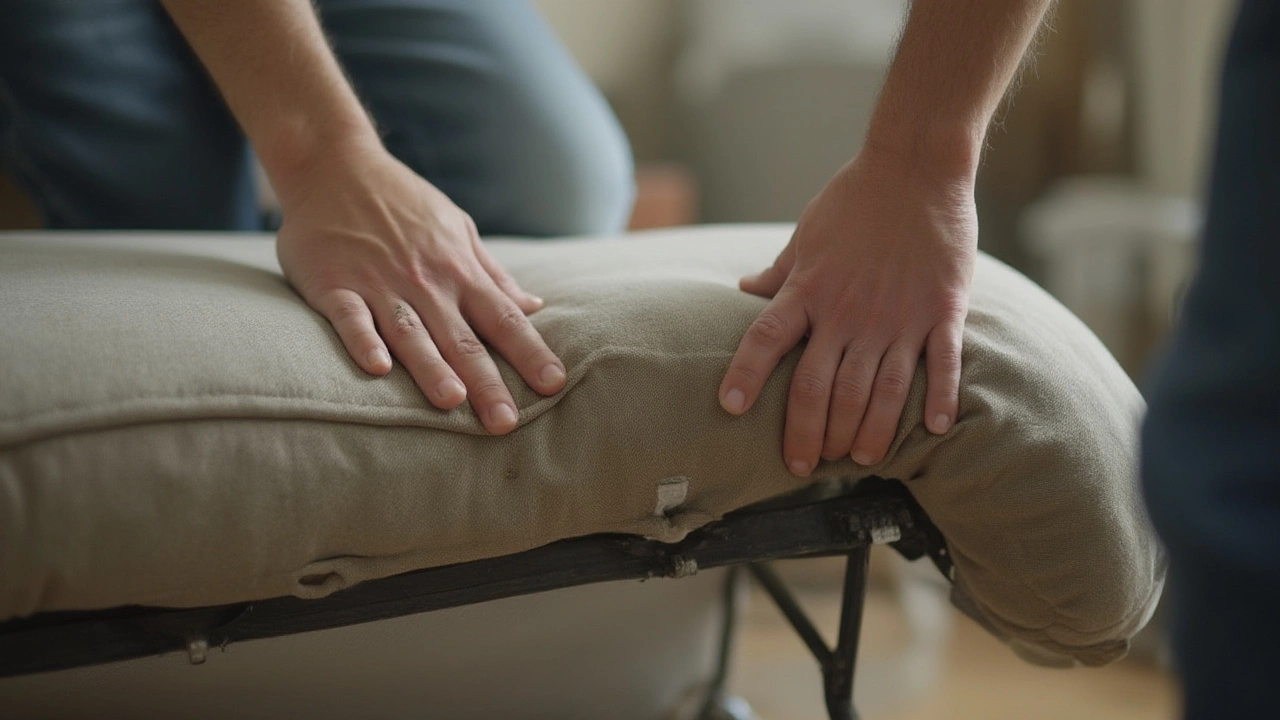Ever sat down on a sofa bed and wondered how many late-night movies, unexpected guests, and lazy Sunday naps it's really got left in it? Turns out, most people expect their sofa beds to keep going for years—almost like they expect from a regular couch. But is that actually true? Some say you should treat a sofa bed as a two-in-one deal, getting the best of both worlds. But here's the truth: not all sofa beds are built to stick around for the same stretch of time. Let's jump straight into what really determines if your trusty pull-out will handle the next sleepover or finally give up the ghost.
What’s the Typical Lifespan of a Sofa Bed?
When it comes to sofa beds, there's no one-size-fits-all answer for how long they last. But here's what most brands and retailers will actually tell you: expect a typical sofa bed to last somewhere between 5 and 10 years if you use it regularly. This range might sound a bit wide, but it’s because so many factors are in play. If your sofa bed is used only for the occasional overnight guest, you could get 15 years or more. Daily use, on the other hand, will put it on the lower end.
Here's a data nugget most don't know: a 2022 consumer survey by Furniture Today found that heavy users of sofa beds often see sagging cushions and tricky mechanisms in as little as 3 years, while light-use models (the ones parked in your spare room) held up for over a decade. Realistically, the average sofa bed in a family home, getting opened up a few times a week, stays comfy and navigable for around 7 years.
The difference comes down to how they're built and who’s using them. Pull-out mechanisms get most of the blame for early breakdowns. Kids jumping on them, adults flopping down, and dog claws can all chip away at the life span.
| Sofa Bed Use Style | Average Lifespan |
|---|---|
| Daily sleeper (main bed) | 3–5 years |
| Weekly guest use | 5–8 years |
| Occasional/rare use | 8–15 years |
So if you’re shopping or considering replacing your old one, keep in mind how much real action your sofa bed will see. A smart tip: Always check the manufacturer’s warranty. If they only cover it for a year or two, take it as a sign that you shouldn’t expect decades.
Factors That Affect a Sofa Bed’s Durability
Not all sofa beds are created equal. There’s a huge difference in how long the budget models from a big-box store and high-end ones from specialty shops will last. Let’s break down what really impacts longevity:
- Frame Material: The heart of any sofa bed. Solid hardwood frames (like oak or maple) will outlive softwood or particleboard construction by years. Metal frames might seem solid, but cheap ones bend, squeak, or jam quickly.
- Mattress Type: Innerspring mattresses are tough but can be uncomfortable. Memory foam feels better and usually holds its shape longer. Thin foam pads (often found in cheaper models) break down fastest.
- Mechanism Quality: It’s what makes a sofa bed a sofa bed—and the main point of breakdown. Steel mechanisms with smooth hinges last far longer. If it feels wobbly in the store, it won’t last at home.
- Frequency of Use: A spare room sleeper will get way more years than your daily Netflix-and-chill sofa bed. Constant folding and unfolding wears out all the moving parts.
- Weight Load: Let’s be honest: jumping kids, hefty adults, and pets all test a sofa bed’s limits. Bigger loads speed up wear and tear on cushions, frames, and mechanisms.
- Care and Cleaning: Leftover snacks, pet hair, and spilled drinks aren’t just gross—they can destroy both mattress and upholstery, which shortens life quickly.
Want to check if your sofa bed is in trouble? Listen for squeaks, creaks, or if it gets “stuck” when opening. These are early warning signs. Also, inspect the inside frame every six months—sometimes you’ll spot a small crack or loose bolt before it turns into a sleepover disaster.
One more pro tip: check the mattress every year for sags or poking springs. If you notice lumps or a dusty smell, it may be breaking down inside, stealing comfort and shaving off usable years.

Easy Ways to Extend the Life of Your Sofa Bed
You don’t have to accept early breakdown. A few habits can keep your sofa bed feeling newer, longer. The main trick? Prevent issues before they get out of hand.
- Use a quality mattress pad or topper if guests complain it’s stiff or thin. This reduces direct wear and stops body oils from soaking into the mattress.
- Keep the mechanism “moving” smoothly. Every few months, give the hinges and moving metal a light spray of silicone-based lubricant—skip oil-based sprays as they attract dust.
- Vacuum the inside and under the cushions regularly. Crumbs and dirt can actually wear down upholstery fibers and foam fast.
- If you live in a humid place, air out the folded mattress. Humidity and warmth trapped inside start up mold and mildew, which ruins mattresses and stinks up the whole room.
- Remind kids the sofa bed isn’t a trampoline. Sure, a little bounce is fun, but repeated jumping will bend the frame and trash the support bars.
- Rotate and flip the mattress if possible. While many sofa bed mattresses aren’t double-sided, if yours is, swapping sides helps level out early wear.
- Don’t overload. Respect the weight limits on the mechanism—it’s tempting to squeeze as many people as possible on there for a movie night, but it’ll kill the longevity.
Spills? Blot, don’t rub. Removing the cover for washing (if yours allows) keeps things fresher and delays the “old couch” smell.
A surprising tip: fold the bed away slowly, never slam it shut. A slow fold protects all the joints and parts that make your 'bed in disguise' work.
Signs Your Sofa Bed Needs Replacing (and When to Repair)
So how do you know when to finally quit on your old sofa bed? There are some tell-tale signs, and a few of them sneak up fast. If you hear grinding metal, notice chronic saggy spots, or see fabric splits at the seams, your sofa bed might be past its prime. Hiding a couch under a blanket or piles of pillows only works for so long—eventually the damage shows through.
If the bed mechanism is impossible to pull out—or snaps right back in after you open it—that’s usually not worth fixing, especially if the frame is also damaged. Comfort matters a ton. If guests start sneaking out to the floor or complain that they woke up bent out of shape, it’s time to upgrade. Breathing in old dust, mold, or mysterious odors also means you're overdue for a replacement.
But if you really love the frame or fabric, some fixes are actually worth a shot. Replacing the mattress is usually cheaper than buying a whole new unit, especially if your mechanism and frame are sound. New foam toppers or springs are a solid move if things have just gotten a little droopy.
Another handy idea: tighten any bolts or hinge screws every year. Sometimes looseness gets mistaken for structural damage, when all you need is a wrench. Dealers will sometimes offer replacement parts for popular models even after warranties expire, so check online before kicking it to the curb.

Choosing a Sofa Bed That Will Last Longer
So you want a sofa bed that lasts as long as possible? Here’s how to pick a winner: go for hardwood frames, not flexible plywood or softwood. Avoid thin foam mattresses and check the weight capacity (the higher, the better). Test out the pull-out mechanism in the store—if it’s jerky, sticky, or makes clangy noises, imagine after hundreds of uses. Doesn’t matter how trendy it looks, construction is king.
The best sofa beds have reinforced rails and crossbars so the back doesn’t start to bow after a year. If the mattress is less than 4 inches thick, expect short lifespans and some annoyed sleepers. Look for brands offering at least a 5-year warranty. Bonus points if replacement parts and mattresses are easy to get years from now.
Some brands even advertise "hospitality grade" or "contract grade" sofa beds—the kind hotels use. Turns out, these really do last longer because they’re made for daily abuse by strangers. If you’ve got space and a few extra dollars, these are worth it. I’ve seen a Hilton hotel sofa bed still going strong after five years of back-to-back guests—try doing that with your bargain model from the local warehouse store.
Last thing—don’t be shy about crawling under in the showroom and checking for sturdy welds, thick wood, and smooth-operating parts. It may sound awkward but think of it as shopping for peace of mind.
Pick the sofa bed lifespan that's right for how you actually live, not just what looks good online. Make a few smart moves and you’ll get a cozy sleep spot that lasts far longer than average.


Write a comment